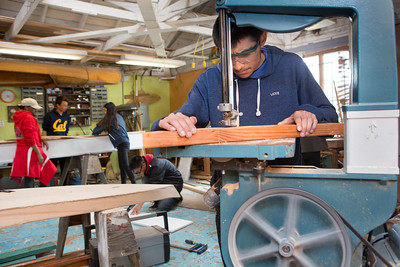Many long-held beliefs in our education system are founded on thin and outdated evidence yet have profound — often detrimental — impacts on the lives and psyches of our students. One that really bothers me? That we, as educators, are supposed to prepare students for college or career, when we all know that the professional trajectory for the majority of our students will lead them across both paths. We do a disservice to them when we imply one has inherently more value than the other. We need stigma-free CTE.
Working in manufacturing and the trade industries today is not the same as it was 10, 20 or 50 years ago. The students who will fill these jobs need to be adaptive problem-solvers who are quick on their feet. They will need to be able to collaborate with diverse sets of coworkers, some of whom may be located halfway around the world. These are not low-skilled jobs; in fact, quite the opposite.
From vocational education to CTE

Sorting “vocational students” from “pre-collegiate students” is an incredibly enduring feature of our public schools. The Smith-Hughes Act of 1917, the law that first authorized federal funding for vocational education in American schools, explicitly made the distinction that vocational education was for students who would not be obtaining a college degree. Debates raged in the early 1900s about how much Greek and Latin should be infused into the curriculum versus more practical and utilitarian skills. In 1908, then-President Teddy Roosevelt stated that public education should be “directing boys and girls back to the farm and shop.”
So, this idea that students are presented with an either/or scenario is firmly rooted in the 20th century. But this is the 21st century, and we really need to have a more holistic view of what students need to be successful in life and ensure stigma-free CTE.
Employees don’t stay in the same job, at the same company, doing the same things day in and day out, until they retire. They may take a promotion or make a lateral move within their industry or change industries altogether. It’s time we rethink the legacy of our education system that is still calibrated to rank and sort students into linear, predictable job paths and instead think about how we can teach and assess mastery of more transversal skills.
I work for a Board of Cooperative Educational Services that is constantly mapping skills and asking the employers in our community who have jobs to offer what they think a young professional in their organization needs to know. Their feedback is pretty consistent. We rarely hear things like “Please teach them how to operate this one kind of machine.” Instead, they want employees with soft skills, such as the ability to solve problems, collaborate well with others, communicate effectively, be leaders, be creative, access multiple literacies, be globally competent and be self-directed. They want them to have skills that can translate to multiple jobs within an industry or vocation.
Current college trajectories aren’t working
Traditional college trajectories do work for some people, and some fields require extensive classroom training that only makes sense in a university setting. But if we look at the past decade and the rise of the information economy, how many of those jobs actually require a traditional four-year degree program?
A survey of freelance workers with four-year degree shows that 21% say their college education isn’t useful to the work they do now. And while 21% may not seem alarming out of hand, the fact that in the next five years freelancers will make up a majority of workers in the US economy, it’s probably worth paying attention to.
This is why it is critical that we provide exposure to career, technical and vocational opportunities earlier on so students can have significant learning experiences by visiting local industries and businesses in their own communities. Many students are pursuing careers without ever having talked to someone working in the field, leaving them with little to no idea if they are a good fit for the job or if it’s a good fit for them.
Students deserve exposure to the people who are actually employing workers locally: exposure to their expertise, to the nature of the work available in their community and to the types of challenges industry leaders in their community are trying to solve.
That might happen through a partnership with an organization like a BOCES, or it might require districts to leverage partnerships with community groups, chambers of commerce and businesses. It’s my experience that the people in our communities who have jobs to fill also tend to be interested altruistically in interacting with the kids in their neighborhoods and helping to shape local workforce development.
Make CTE rigorous, engaging and for everyone
When I ask my own 14-year-old daughter what she’s learning in her traditional school, she’s not able to tell me. She can tell me about her worksheets, her assignments and her books. If I ask a 14-year-old in our stigma-free CTE programs, she not only can show me what she’s working on but also the essential question she’s trying to answer, her opinion on what those answers might be and why the work is important to someone other than herself.
Vocational education can be rigorous and engaging, and it can encourage students to collaborate and build real-world relationships with future employers and community members. In fact, many more students would thrive and our workforce would be more exceptional if we removed the stigma from CTE and encouraged more students to explore it as an option as early as possible.
Peter Harris is director of learning and design for the career pathways programs at Ulster BOCES in New Paltz, N.Y. Reach out to him via email.
________________________________
Subscribe now to SmartBrief’s FREE email newsletter from ASCD. It’s among SmartBrief’s more than 250 industry-focused newsletters, including CTU.
More from SmartBrief Education:
- 5 ways new school-home communication meets family, staff needs
- 5 virtual-classroom tools to foster authentic connections
- Changing the classroom experience with instructional audio
- Powerful social media solutions for students
- How comics curriculum boosts SEL
- 8 ways to make vocabulary instruction more effective
